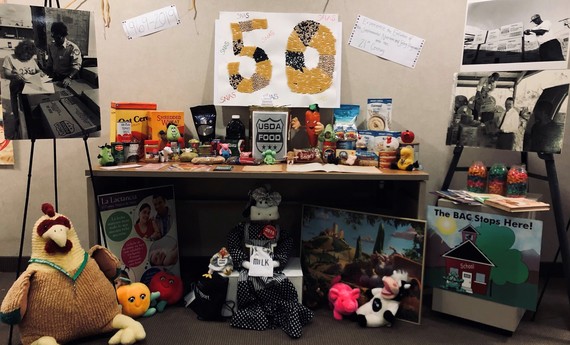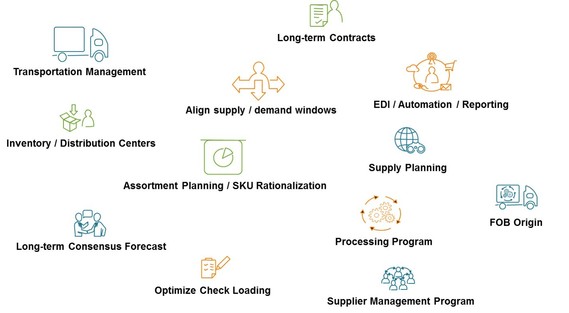Trade Mitigation Update

As many of you know, in August 2018, USDA announced a plan to support farmers in response to trade retaliation and FNS has played an important role in the ordering and procurement of trade mitigation products in 2019.
As of this month, all orders for delivery in 2019 have been submitted and FNS is working with AMS to purchase them. The 2019 Food Purchase and Distribution Program offered an opportunity to procure some unique products, including grapes, pistachios, and figs and orders for these three products totaled just under $80 million. Together, FNS and AMS have awarded over 3,500 trucks of pork products, 2,000 trucks of rice, and 2,000 trucks of fresh apples.
Similar to the efforts the Department executed throughout 2019, Agriculture Secretary Sonny Perdue announced in May 2019 that USDA would take several actions to assist farmers suffering from trade disruption. USDA plans to provide up to $16 billion in programs, which is in line with the estimated financial impacts of the trade disruption. Similar to 2019, the CCC Charter Act authority will be used to implement a $1.4 billion Food Purchase and Distribution Program (FPDP) to purchase surplus commodities affected by trade retaliation such as fruits, vegetables, some processed foods, beef, pork, lamb, poultry, and milk for distribution by FNS to food banks, schools, and other outlets.
Managing these large amounts of orders takes cooperation and coordination between all parties and we thank you, our partners, for your participation and flexibility.
|
Catfish Processing
In May, USDA staff visited USDA Foods catfish vendors in Mississippi. Catfish is available for order through USDA Foods in Schools, The Emergency Food Assistance Program (TEFAP), and as a traditional food offering in the Food Distribution Program on Indian Reservations (FDPIR).
During the visit, USDA staff were able to see catfish throughout the process from the ponds to harvesting, processing, and packing for delivery. We also learned about flavor checkers in each facility who ensure that the catfish is ready for harvest by evaluating samples from the pond to ensure a consistent, high quality flavor. Thanks to the catfish industry for taking USDA behind the scenes to see how our USDA Foods products get from the pond to the table!
Catfish Harvesting
TEFAP and the Good Samaritan Act
The 2018 Farm Bill directed USDA to issue guidance promoting awareness of protections for donations of apparently wholesome food by qualified direct donors under the Bill Emerson Good Samaritan Food Donation Act. That guidance was issued on June 18, 2019 in a memorandum which provides information to TEFAP State agencies and eligible recipient agencies, such as Food Banks, on protections for privately donated foods provided to them.
Under the Act, nonprofit organizations and individuals donating food do not face civil or criminal liability if a donated food harms someone, assuming the food appeared wholesome and was donated in good faith, and as long as donations were made in compliance with applicable State and local laws and regulations. To read the memorandum in full, visit this link.
School Nutrition Association (SNA) Annual National Conference (ANC) Recap
USDA staff had the opportunity to interact with many of our USDA Foods in schools stakeholders at the SNA ANC, held July 14-16 in St. Louis, Missouri. Many State, school districts, and industry partners stopped by the USDA Foods booth during expo hours. We appreciated seeing you and listening to your feedback about USDA Foods.
The “USDA Foods Update” session included highlights about new USDA Foods products, the USDA DoD Fresh Fruit and Vegetable Program, inventory management, the USDA Foods photo contest, and more. We also provided updates on USDA Foods along with our partners in Child Nutrition during the USDA State Agency Section meeting and USDA update session. This provided us with an another opportunity to hear from our stakeholders.
USDA shared an important annual reminder during the USDA Foods recall session to check that contact information in Web Based Supply Chain Management (WBSCM) Rapid Alert is accurate to ensure information about a USDA Foods recall is received.
The exhibit hall provided opportunity to see a variety of different types of products that manufacturers who participate in the USDA Foods processing program offer to schools. We were excited to taste several new dark meat chicken products. These products ensure that schools have a variety of products to utilize both white and dark meat.
Feeding America Senior Hunger Research
Feeding America recently released its State of Senior Hunger in America report that includes information and statistics about hunger in the age 60 and older population. The data collected in 2017 concluded that 7.7% of seniors are food insecure and provides additional information about the highest rates of food insecurity by State, income level, race, age, gender, and other factors. Check out the webpage for the full report, executive summary, and infographics.
If you are interested in how food assistance programs contribute to meeting the needs of seniors, be sure to check out the 2018 report An Evaluation Report: Senior Food-Assistance, Related Programming, and Seniors’ Experiences Across the Feeding America Network.
CSFP Sharing Gallery: Supporting Nutrition Education Resource Sharing
To support programs in carrying out nutrition education with CSFP participants, USDA recently launched the CSFP Sharing Gallery! The Sharing Gallery is a public website that includes handouts, recipes, lesson plans, and other resources to support local level nutrition education efforts for seniors. While USDA previously hosted a Nutrition Education Resource page, the Sharing Gallery is different in that it offers States and local programs the opportunity to submit CSFP-specific resources to share with other program sites across the country.
If you have nutrition education resources or recipes to share, please review our inclusion criteria and recipe criteria first, then send appropriate materials to USDAFoods@usda.gov. USDA will review and post new resources to the site on a regular basis.
FNS has a new Website: Take a Look inside!
In April, FNS unveiled a new and improved website designed to make finding information about our programs, services, and resources much easier. If you are accustomed to old website, you may find it takes a little more time to find the information you need. To get started:
- Visit our website at www.fns.usda.gov. For an optimal viewing experience, use Firefox, Chrome, or Internet Explorer 11.
- To find information about a specific program, click the Programs tab in the toolbar to view a list of programs. You can also scroll down to the middle of the homepage to locate a program by FNS Program Area. TIP: When searching by FNS Program Area, don’t forget to click the Learn More button to view the programs in that selection.
If you have any issues locating resources related to USDA Foods in Schools, FDPIR, TEFAP or CSFP, please contact us at USDAFoods@usda.gov.

Refresher on FNS Instruction 709-5: Shipment and Receipt of USDA Foods
This webinar will provide USDA FNS Regional Offices, State Agencies, Recipient Agencies, and warehouses a refresher on the FNS Instruction 709-5: Shipment and Receipt of USDA Foods. The webinar will highlight the five key areas involved with the shipment and receipt of USDA Foods: arranging shipment and delivery, guidance on inspecting the shipment, accepting and receipting the shipment, unloading the shipment, and disposition and replacement of USDA Foods. In addition, E-invoicing in WBSCM and filing complaints will be covered. Attendees will take away a better understanding of the 709-5 policy.
September 5, 2019 at 1:00pm ET Register here.
This webinar is applicable to all USDA Foods Programs.
|
Are you Ready for the CSFP Food Package Changes?
Join us Thursday, September 19 to find out if you are ready for the CSFP Enhanced Food Package that goes into effect November 1, 2019. This webinar will cover transition updates regarding direct shipment purchase status and food availability from the National Warehouses including when to expect new foods and package sizes to be available for multi-food ordering. In addition, attendees will have the opportunity to ask any additional questions before implementing the enhanced food package.
September 19, 2019 at 1:00pm ET Register here.
Serving America for 50 Years
This year FNS is celebrating 50 remarkable years of service. FNS programs not only serve as the first line of defense against hunger, but also improve the quality of life for low-income people and communities across America.
In order to celebrate the 50th anniversary of FNS the National Office Headquarters and the Regional Offices held an office-decorating contest. USDA Foods program staff collected newspaper clippings, old photographs, banners, and historic USDA Foods materials from the past 50 years. Our display won awards for “Best Representation of the FNS Mission” and “Most Spirited.” The display, a portion of which is pictured below, highlights the work we do each day – past, present, and future.
Thanks for being a part of the important work that FNS does every day and we look forward to another 50 plus remarkable years of USDA Foods!

BMI Update: Requirement Gathering and Validation
Previous work on the Business Management Improvement (BMI) project identified several opportunities for improvement.
 Following a set of operational pilots in 2018, the focus has shifted to gathering and validating detailed business and functional requirements. This information will help to ensure that technology is able to support the envisioned end-to-end processes for USDA’s food distribution programs.
USDA employees have been engaged in weekly workshops to review and refine Future State Process Maps for each functional area. The goal is to finalize these requirements by the end of 2019 with system development and system integration activities to follow.
New Receipting View for WBSCM
WBSCM is phasing in a streamlined process called electronic invoicing (eINV) for creating and reconciling advanced shipment notifications (ASN), goods receipts, and invoices for materials shipped directly from a commodity vendor. Beginning in Fall 2019, new Purchase Orders (POs) for direct delivery materials will use eINV. Any remaining shipments for existing POs will continue to use the existing receipting process during a transition period. There are no changes to the existing process for uploading receipts or receipting multifood deliveries from the National Warehouses.
 The key changes with eINV include:
- There are two new fields: Further Actions and Receipt Status.
- The fields for entering good, damaged, and rejected quantities appear in a different order. Additionally, a good quantity may be pre-populated and/or calculated automatically. Users should check the column header to ensure the good quantity is entered in the correct column.
- If available, the quantity from the ASN is pre-populated in the applicable good quantity field.
- For variable weight items, the weight is calculated automatically after the Good Qty (in CS) is submitted.
- To fix typos or update information for recently entered receipts, an option is available to Modify Receipt. In most cases, it is no longer necessary to open a WBSCM incident.
Although the process for receipting is essentially the same, separate versions of the work instructions are available for the DOMESTIC_VIEW and the new EINV_VIEW with corresponding screenshots, notes, and additional steps for modifying receipts (eINV only).
To report system issues or request assistance with receipting, please contact the WBSCM Helpdesk at 877-WBSCM-4U (877-927-2648) or by email to WBSCM.servicedesk@CACI.com.
WBSCM System Upgrade
In mid-September, the Web-Based Supply Chain Management (WBSCM) system will introduce several improvements across the system, including a new search capability on the Home page. This will allow users to search by keyword and access matches from the results list rather than browsing through multiple screens:
 Other changes include:
- Historical values listed for input fields
- Filter some columns by clicking header
- New look for Match Code search
- Download files to a virtual “Z” drive
- Improved web accessibility features and content organization
- Minor aesthetic updates (e.g., typos fixed)
After the upgrade, WBSCM will not automatically have access to the clipboard. Users can adjust Internet Options settings for the IE browser to grant permission. Go to Security > Custom Level. Scroll down to the Scripting settings, and enable Allow Programmatic clipboard access. If this setting is not changed, users will be prompted to grant permission each time they are copying or pasting in WBSCM.
WBSCM training materials may be found by navigating to Help > Training. Recent changes and new documents are highlighted in the announcement banner. For the September upgrade, new job aids will include an overview of the system changes, a glossary of terminology, and a guide to user experience/accessibility features. Additionally, the video tutorial for WBSCM navigation will be updated.
All WBSCM users will receive more information about these changes in upcoming communications from the support team. Please direct questions to the WBSCM Service Desk or call (877) 927-2648.
|